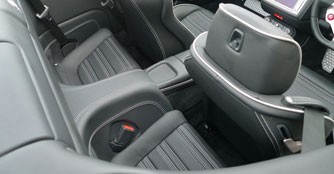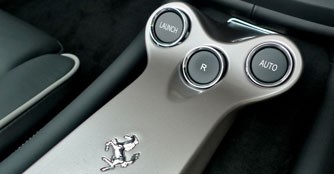Ferrari California 30 4.3 (A) Review
10 Aug 2012|17,864 views
When Ferrari launched the California in 2009, detractors of the Prancing Horse criticised it for its unpretty and somewhat heavy looks, weighty folding metal hard top design and its relatively tame nature compared to more traditional Ferrari models like the 599GTB Fiorano.
Three years on and the California have proved its critics wrong with its healthy sales numbers. Just in case, you're wondering about its California name, California is actually one of Ferrari's most evocative names – it was first used in the ultra desirable 1950s 250GT California.
The California was after all conceived to be an entry-level Ferrari that is user friendly and with none of the intimidating driving characteristics and overtly powerful performance that is associate with the brand.
To put it simply, the California was meant to be a Ferrari that the Missus can drive to her high tea appointments. To address the needs of more enthusiastic California drivers though, the California needs even more performance and a more dynamic feel, hence its mid-life refresh recently. Dubbed the California 30, the essence of the updated model is its additional 30 horsepower and its 30kg lighter kerb weight.
Exterior
The California's styling was heavily criticised when it first debut at the 2008 Paris Motor Show. Honestly, I wasn't a fan either, especially its rear where it looked like it had a butt the size of J Lo's.
Three years on and the California have proved its critics wrong with its healthy sales numbers. Just in case, you're wondering about its California name, California is actually one of Ferrari's most evocative names – it was first used in the ultra desirable 1950s 250GT California.
The California was after all conceived to be an entry-level Ferrari that is user friendly and with none of the intimidating driving characteristics and overtly powerful performance that is associate with the brand.
To put it simply, the California was meant to be a Ferrari that the Missus can drive to her high tea appointments. To address the needs of more enthusiastic California drivers though, the California needs even more performance and a more dynamic feel, hence its mid-life refresh recently. Dubbed the California 30, the essence of the updated model is its additional 30 horsepower and its 30kg lighter kerb weight.
Exterior
The California's styling was heavily criticised when it first debut at the 2008 Paris Motor Show. Honestly, I wasn't a fan either, especially its rear where it looked like it had a butt the size of J Lo's.
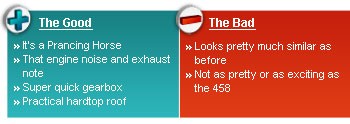 |
Looking at it in the flesh during our drive convinced me otherwise though - the California's petite proportions makes it look like a scaled down 599 from some angles and that backside isn’t that fat after all considering that it stores the two piece roof as well as a boot that is more useable than some four-seat hardtop convertibles.
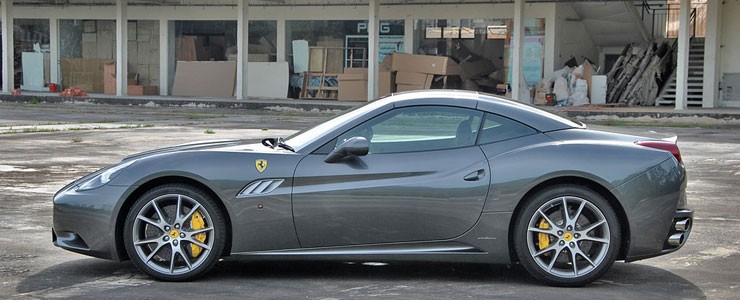 |
The styling of Ferraris has always been more about function rather than style so aerodynamics plays an important part in the car’s overall performance. Ferrari says that the California is their most aerodynamically efficient model ever thanks to a drag coefficient figure of 0.32.
Once again, Ferrari has worked with Pininfarina on the California’s exterior. The references to its 599 sibling are clear when viewed from the front but the California has distinctive flanks that feature a very prominent swage line that runs from the air vents on the front wings and end as wide haunches along the boot line.
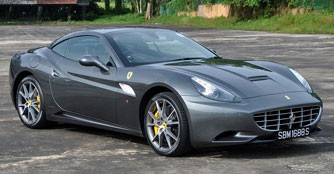
 Distinctive flanks that feature a prominent swage line on the side separates the California from its 599 sibling
Distinctive flanks that feature a prominent swage line on the side separates the California from its 599 sibling
The rear features the signature circular tail lamps (they are only daytime running lights actually) with secondary tail lamp clusters on the lower bumper. The large air outlet on the lower bumper and the vertically stack tail pipes do give the California’s back a purposeful stance.
The California’s looks certainly divides opinions but we reckon that the styling grows over time like past Ferraris have. Top up or down, the California definitely looks sexy enough to deserve the supercar tag. The updated car can be differentiated by the matte aluminium finish for its signature front fender air vents while the car pictured here wears optional 20-inch multi-spoke wheels for an even sportier stance overall.
Once again, Ferrari has worked with Pininfarina on the California’s exterior. The references to its 599 sibling are clear when viewed from the front but the California has distinctive flanks that feature a very prominent swage line that runs from the air vents on the front wings and end as wide haunches along the boot line.

The rear features the signature circular tail lamps (they are only daytime running lights actually) with secondary tail lamp clusters on the lower bumper. The large air outlet on the lower bumper and the vertically stack tail pipes do give the California’s back a purposeful stance.
The California’s looks certainly divides opinions but we reckon that the styling grows over time like past Ferraris have. Top up or down, the California definitely looks sexy enough to deserve the supercar tag. The updated car can be differentiated by the matte aluminium finish for its signature front fender air vents while the car pictured here wears optional 20-inch multi-spoke wheels for an even sportier stance overall.
The California’s two piece hard top roof operates in a graceful way – with the press of a button, it tucks away in just 14 seconds to convert the California from a coupe to a roadster. Despite the weight and styling disadvantage, the benefits of the California’s folding metal hardtop design are obvious – better sound insulation and security.
Interior
Inside, the California 30 remains unchanged, which means a superbly executed cabin that is more than worthy of its price tag. An especially neat feature is the sculpted aluminium console between the front seats – it looks like it has been machined from a solid billet of aluminium.
Despite its petite looks, the California is actually a 2+2 so you can squeeze a couple of mates at the rear to share the Ferrari experience with them.
Interior
Inside, the California 30 remains unchanged, which means a superbly executed cabin that is more than worthy of its price tag. An especially neat feature is the sculpted aluminium console between the front seats – it looks like it has been machined from a solid billet of aluminium.
Despite its petite looks, the California is actually a 2+2 so you can squeeze a couple of mates at the rear to share the Ferrari experience with them.
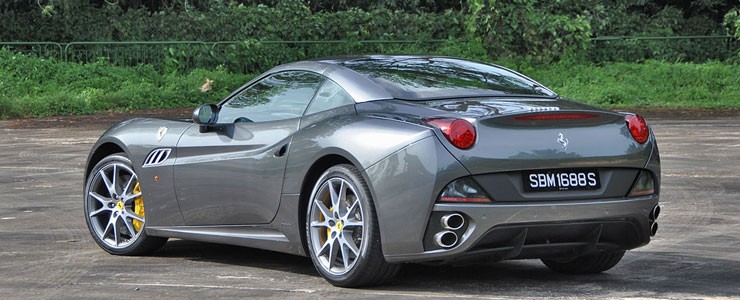 |
The Drive
Under the bonnet lies the same mid-front mounted 4297cc V8 with direct injection from the pre-updated model, albeit with an additional 30bhp and 20Nm thanks to new exhaust manifolds and engine mapping. The bent eight shares its flat crankshaft and 90 degree vee angle design with the F430 and 430 Scuderia’s V8 and now makes a total of 490bhp at 7750rpm. In typical Ferrari fashion, it is a high revving unit that is redlined close to 8000rpm.
The California’s unit isn’t as powerful as those in the mid-engined V8 models but it has a fatter and flatter torque curve – up to 505Nm of which is available at 5000rpm. This translates to a V8 that is incredibly flexible at any given engine speed. Admittedly, the frenetic nature of the 458’s motor at high revs is compromised with the California’s unit in order to sacrifice for better drivability.
0-100km/h comes up in a scant 3.8 seconds with top speed rated at 312km/h, numbers that are improvement over the old car’s 3.9 seconds and 310km/h. Obviously, the improvement in straightline performance is a combination of both the extra power and the 30kg overall reduction in weight. The latter is achieved by the introduction of new, cutting edge aluminium fabrication techniques and construction technologies in the manufacture of the California’s chassis, says Ferrari.
Mated to the V8 is an ultra fast dual clutch gearbox that is also used in the 458. The gearbox is mounted at the rear to enhance weight distribution. Like Ferrari’s F1 robotised manual boxes, the California’s seven-speeder is operated by the steering column mounted paddles, with reverse selected by a button on the console between the front seats.
Also on the centre console is a button labelled ‘Launch’ for maximum acceleration runs from standstill. The gearbox is a wonderful delight – operating smoothly when pottering along and yet decisively quick with its shifts when you pull back on the right flappy paddle or when the manettino is set in Sport mode. Manettino is a toggle switch located below the steering wheel used to alternate between Sport, Comfort and CST off (all driver aids turned off).
Under the bonnet lies the same mid-front mounted 4297cc V8 with direct injection from the pre-updated model, albeit with an additional 30bhp and 20Nm thanks to new exhaust manifolds and engine mapping. The bent eight shares its flat crankshaft and 90 degree vee angle design with the F430 and 430 Scuderia’s V8 and now makes a total of 490bhp at 7750rpm. In typical Ferrari fashion, it is a high revving unit that is redlined close to 8000rpm.
The California’s unit isn’t as powerful as those in the mid-engined V8 models but it has a fatter and flatter torque curve – up to 505Nm of which is available at 5000rpm. This translates to a V8 that is incredibly flexible at any given engine speed. Admittedly, the frenetic nature of the 458’s motor at high revs is compromised with the California’s unit in order to sacrifice for better drivability.
0-100km/h comes up in a scant 3.8 seconds with top speed rated at 312km/h, numbers that are improvement over the old car’s 3.9 seconds and 310km/h. Obviously, the improvement in straightline performance is a combination of both the extra power and the 30kg overall reduction in weight. The latter is achieved by the introduction of new, cutting edge aluminium fabrication techniques and construction technologies in the manufacture of the California’s chassis, says Ferrari.
Mated to the V8 is an ultra fast dual clutch gearbox that is also used in the 458. The gearbox is mounted at the rear to enhance weight distribution. Like Ferrari’s F1 robotised manual boxes, the California’s seven-speeder is operated by the steering column mounted paddles, with reverse selected by a button on the console between the front seats.
Also on the centre console is a button labelled ‘Launch’ for maximum acceleration runs from standstill. The gearbox is a wonderful delight – operating smoothly when pottering along and yet decisively quick with its shifts when you pull back on the right flappy paddle or when the manettino is set in Sport mode. Manettino is a toggle switch located below the steering wheel used to alternate between Sport, Comfort and CST off (all driver aids turned off).
A new option for the California 30 that is fitted on the test car is the Handling Speciale (HS) package that is supposed to improve handling and add a more dynamic feel to the California’s overall road holding. The HS package consists of Magnetorheological dampers that are controlled by a 50 percent faster ECU running patented Ferrari software, stiffer springs and a new steering box that is quicker than standard.
In Sport mode, the 599 derived magnetic dampers firm up to beef up body control in the corners. Its overall handling is a really pleasant surprise considering that it has to be a drivable car day in day out. Drive it hard and it’ll demonstrate to you what a Ferrari is all about. Potter along at town speeds and it’ll show its user friendliness with a well-damped and comfortable ride, especially in Comfort mode.
The California’s road behaviour is a near perfect compromise between being that of a thoroughbred sports car and a comfortable grand tourer.
Conclusion
In true Ferrari fashion, the updates to the California are confined to the most important bits – the mechanical stuff. In the California’s case, these tweaks have made the most affordable Ferrari an even more exhilarating drive than before.
When Ferrari launched the California in 2009, detractors of the Prancing Horse criticised it for its unpretty and somewhat heavy looks, weighty folding metal hard top design and its relatively tame nature compared to more traditional Ferrari models like the 599GTB Fiorano.
Three years on and the California have proved its critics wrong with its healthy sales numbers. Just in case, you're wondering about its California name, California is actually one of Ferrari's most evocative names – it was first used in the ultra desirable 1950s 250GT California.
The California was after all conceived to be an entry-level Ferrari that is user friendly and with none of the intimidating driving characteristics and overtly powerful performance that is associate with the brand.
To put it simply, the California was meant to be a Ferrari that the Missus can drive to her high tea appointments. To address the needs of more enthusiastic California drivers though, the California needs even more performance and a more dynamic feel, hence its mid-life refresh recently. Dubbed the California 30, the essence of the updated model is its additional 30 horsepower and its 30kg lighter kerb weight.
Exterior
The California's styling was heavily criticised when it first debut at the 2008 Paris Motor Show. Honestly, I wasn't a fan either, especially its rear where it looked like it had a butt the size of J Lo's.
Three years on and the California have proved its critics wrong with its healthy sales numbers. Just in case, you're wondering about its California name, California is actually one of Ferrari's most evocative names – it was first used in the ultra desirable 1950s 250GT California.
The California was after all conceived to be an entry-level Ferrari that is user friendly and with none of the intimidating driving characteristics and overtly powerful performance that is associate with the brand.
To put it simply, the California was meant to be a Ferrari that the Missus can drive to her high tea appointments. To address the needs of more enthusiastic California drivers though, the California needs even more performance and a more dynamic feel, hence its mid-life refresh recently. Dubbed the California 30, the essence of the updated model is its additional 30 horsepower and its 30kg lighter kerb weight.
Exterior
The California's styling was heavily criticised when it first debut at the 2008 Paris Motor Show. Honestly, I wasn't a fan either, especially its rear where it looked like it had a butt the size of J Lo's.
Looking at it in the flesh during our drive convinced me otherwise though - the California's petite proportions makes it look like a scaled down 599 from some angles and that backside isn’t that fat after all considering that it stores the two piece roof as well as a boot that is more useable than some four-seat hardtop convertibles.
The styling of Ferraris has always been more about function rather than style so aerodynamics plays an important part in the car’s overall performance. Ferrari says that the California is their most aerodynamically efficient model ever thanks to a drag coefficient figure of 0.32.
Once again, Ferrari has worked with Pininfarina on the California’s exterior. The references to its 599 sibling are clear when viewed from the front but the California has distinctive flanks that feature a very prominent swage line that runs from the air vents on the front wings and end as wide haunches along the boot line.
The rear features the signature circular tail lamps (they are only daytime running lights actually) with secondary tail lamp clusters on the lower bumper. The large air outlet on the lower bumper and the vertically stack tail pipes do give the California’s back a purposeful stance.
The California’s looks certainly divides opinions but we reckon that the styling grows over time like past Ferraris have. Top up or down, the California definitely looks sexy enough to deserve the supercar tag. The updated car can be differentiated by the matte aluminium finish for its signature front fender air vents while the car pictured here wears optional 20-inch multi-spoke wheels for an even sportier stance overall.
Once again, Ferrari has worked with Pininfarina on the California’s exterior. The references to its 599 sibling are clear when viewed from the front but the California has distinctive flanks that feature a very prominent swage line that runs from the air vents on the front wings and end as wide haunches along the boot line.
The rear features the signature circular tail lamps (they are only daytime running lights actually) with secondary tail lamp clusters on the lower bumper. The large air outlet on the lower bumper and the vertically stack tail pipes do give the California’s back a purposeful stance.
The California’s looks certainly divides opinions but we reckon that the styling grows over time like past Ferraris have. Top up or down, the California definitely looks sexy enough to deserve the supercar tag. The updated car can be differentiated by the matte aluminium finish for its signature front fender air vents while the car pictured here wears optional 20-inch multi-spoke wheels for an even sportier stance overall.
The California’s two piece hard top roof operates in a graceful way – with the press of a button, it tucks away in just 14 seconds to convert the California from a coupe to a roadster. Despite the weight and styling disadvantage, the benefits of the California’s folding metal hardtop design are obvious – better sound insulation and security.
Interior
Inside, the California 30 remains unchanged, which means a superbly executed cabin that is more than worthy of its price tag. An especially neat feature is the sculpted aluminium console between the front seats – it looks like it has been machined from a solid billet of aluminium.
Despite its petite looks, the California is actually a 2+2 so you can squeeze a couple of mates at the rear to share the Ferrari experience with them.
Interior
Inside, the California 30 remains unchanged, which means a superbly executed cabin that is more than worthy of its price tag. An especially neat feature is the sculpted aluminium console between the front seats – it looks like it has been machined from a solid billet of aluminium.
Despite its petite looks, the California is actually a 2+2 so you can squeeze a couple of mates at the rear to share the Ferrari experience with them.
The Drive
Under the bonnet lies the same mid-front mounted 4297cc V8 with direct injection from the pre-updated model, albeit with an additional 30bhp and 20Nm thanks to new exhaust manifolds and engine mapping. The bent eight shares its flat crankshaft and 90 degree vee angle design with the F430 and 430 Scuderia’s V8 and now makes a total of 490bhp at 7750rpm. In typical Ferrari fashion, it is a high revving unit that is redlined close to 8000rpm.
The California’s unit isn’t as powerful as those in the mid-engined V8 models but it has a fatter and flatter torque curve – up to 505Nm of which is available at 5000rpm. This translates to a V8 that is incredibly flexible at any given engine speed. Admittedly, the frenetic nature of the 458’s motor at high revs is compromised with the California’s unit in order to sacrifice for better drivability.
0-100km/h comes up in a scant 3.8 seconds with top speed rated at 312km/h, numbers that are improvement over the old car’s 3.9 seconds and 310km/h. Obviously, the improvement in straightline performance is a combination of both the extra power and the 30kg overall reduction in weight. The latter is achieved by the introduction of new, cutting edge aluminium fabrication techniques and construction technologies in the manufacture of the California’s chassis, says Ferrari.
Mated to the V8 is an ultra fast dual clutch gearbox that is also used in the 458. The gearbox is mounted at the rear to enhance weight distribution. Like Ferrari’s F1 robotised manual boxes, the California’s seven-speeder is operated by the steering column mounted paddles, with reverse selected by a button on the console between the front seats.
Also on the centre console is a button labelled ‘Launch’ for maximum acceleration runs from standstill. The gearbox is a wonderful delight – operating smoothly when pottering along and yet decisively quick with its shifts when you pull back on the right flappy paddle or when the manettino is set in Sport mode. Manettino is a toggle switch located below the steering wheel used to alternate between Sport, Comfort and CST off (all driver aids turned off).
Under the bonnet lies the same mid-front mounted 4297cc V8 with direct injection from the pre-updated model, albeit with an additional 30bhp and 20Nm thanks to new exhaust manifolds and engine mapping. The bent eight shares its flat crankshaft and 90 degree vee angle design with the F430 and 430 Scuderia’s V8 and now makes a total of 490bhp at 7750rpm. In typical Ferrari fashion, it is a high revving unit that is redlined close to 8000rpm.
The California’s unit isn’t as powerful as those in the mid-engined V8 models but it has a fatter and flatter torque curve – up to 505Nm of which is available at 5000rpm. This translates to a V8 that is incredibly flexible at any given engine speed. Admittedly, the frenetic nature of the 458’s motor at high revs is compromised with the California’s unit in order to sacrifice for better drivability.
0-100km/h comes up in a scant 3.8 seconds with top speed rated at 312km/h, numbers that are improvement over the old car’s 3.9 seconds and 310km/h. Obviously, the improvement in straightline performance is a combination of both the extra power and the 30kg overall reduction in weight. The latter is achieved by the introduction of new, cutting edge aluminium fabrication techniques and construction technologies in the manufacture of the California’s chassis, says Ferrari.
Mated to the V8 is an ultra fast dual clutch gearbox that is also used in the 458. The gearbox is mounted at the rear to enhance weight distribution. Like Ferrari’s F1 robotised manual boxes, the California’s seven-speeder is operated by the steering column mounted paddles, with reverse selected by a button on the console between the front seats.
Also on the centre console is a button labelled ‘Launch’ for maximum acceleration runs from standstill. The gearbox is a wonderful delight – operating smoothly when pottering along and yet decisively quick with its shifts when you pull back on the right flappy paddle or when the manettino is set in Sport mode. Manettino is a toggle switch located below the steering wheel used to alternate between Sport, Comfort and CST off (all driver aids turned off).
A new option for the California 30 that is fitted on the test car is the Handling Speciale (HS) package that is supposed to improve handling and add a more dynamic feel to the California’s overall road holding. The HS package consists of Magnetorheological dampers that are controlled by a 50 percent faster ECU running patented Ferrari software, stiffer springs and a new steering box that is quicker than standard.
In Sport mode, the 599 derived magnetic dampers firm up to beef up body control in the corners. Its overall handling is a really pleasant surprise considering that it has to be a drivable car day in day out. Drive it hard and it’ll demonstrate to you what a Ferrari is all about. Potter along at town speeds and it’ll show its user friendliness with a well-damped and comfortable ride, especially in Comfort mode.
The California’s road behaviour is a near perfect compromise between being that of a thoroughbred sports car and a comfortable grand tourer.
Conclusion
In true Ferrari fashion, the updates to the California are confined to the most important bits – the mechanical stuff. In the California’s case, these tweaks have made the most affordable Ferrari an even more exhilarating drive than before.
Car Information
Ferrari California H30 4.3 (A)
CAT B|Petrol|7.6km/L
Horsepower
365kW (490 bhp)
Torque
505 Nm
Acceleration
3.8sec (0-100km /hr)
This model is no longer being sold by local distributor
All Used Ferrari California H30Thank You For Your Subscription.





























